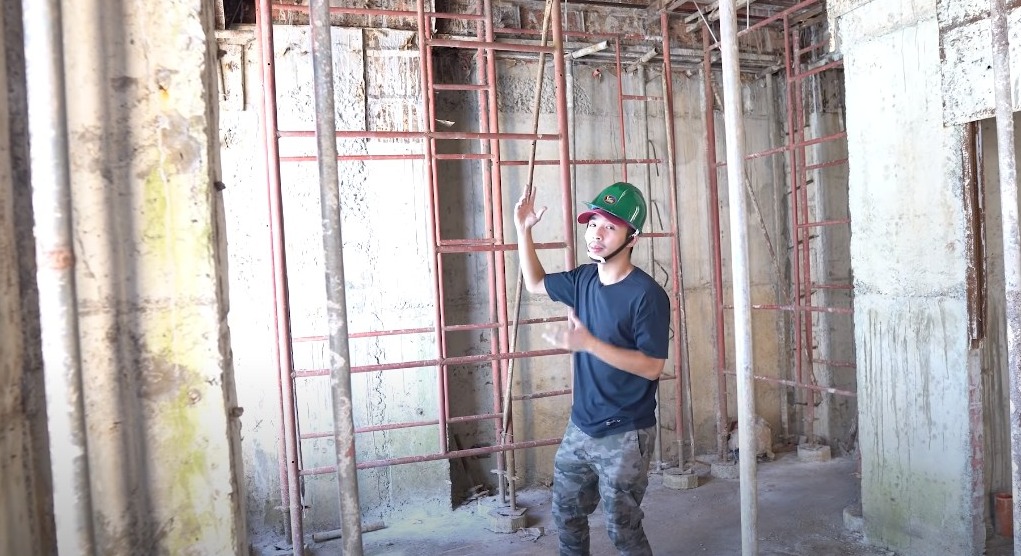The one and only Pinoy Architect Llyan Oliver Austria posted another site visit video on his YouTube channel. But instead of making it just a boring (What’s boring? Does he even know that?) segment on his channel. He added his signature recipe of entertainment and information.
In this video, he mostly talked about formworks and the H-Frame parts and their purposes in construction.
For the benefit of everyone, let’s start this article with the basic terms.
Formworks 101 based on Pinoy Architect’s video
Formwork is a term used in the construction field to signify the temporary mold that is created to “form” the concrete for slabs (a house’s floor or ceiling). In the early times, it is usually made with timber. But as technology grew and more innovations were seen, there are also steel, reinforced plastics, glass fibers, and other materials used for the same purpose.
Concrete pouring is when concrete is poured, usually, a part of the columns are left out, so the pouring of the slab will be more stable as it will mix with the concrete and reinforcements of the previous floor’s column, or in case of the ground floor, the foundation.
Reinforcements are strengthening materials used to add more strength to a certain material. In construction, the most common material needing reinforcements is concrete. A house that is built with just concrete can easily crack and tumble. But when you put steel reinforcements within the concrete, it becomes significantly sturdier.
Curing is a term used to signify the period in which freshly poured concrete settles and dries. The usual period is 7 days or more, depending on outside forces like rain and temperature.
Scaffolding, which also called staging is a temporary provisional framework that is used to support the building’s structure as well as act as a platform for the workers to access higher parts of the structure. Sometimes, scaffolding is also used as the base framework of the building during concrete pouring.
H-Frame is a type of scaffolding that (obviously) is H-shaped. It is a type of scaffolding that consists of two vertical, and two horizontal welded frames that are shaped liked an H.
Centering Formwork – this is the formwork/staging done for slab pouring.
Shuttering Formwork – this is the formwork/staging done for columns and wall concrete pouring.
H-Frame explanation
In Llyan Austria’s video, he first explained the difference between scaffolding and the actual formwork or staging of the building. According to him, scaffolding is just meant to be used by workers to reach the otherwise unreachable parts of the building. Formwork on the other hand has a double purpose. It acts as a scaffold for the workers, as well as the staging of the structure.


One type of scaffold that can also be used in staging is the H-frame. It was designed to be sturdy enough to carry the structure weight as well as the workers.
Parts of slab staging
- Cement spacer – these small spacers are placed on the ground with the vertical support of the H-frame directly above it. This distributes the force further instead of having all the force of the weight carried by the shoring of the frame’s vertical components.
- Soil sill or mudsill – this is only used when the scaffold will be directly installed on top of mud or soil. Concrete spacers are used when the surface is concrete. These two are used to distribute the weight further instead of having all the load bore by the vertical supports.
- Scaffolding jack base – this looks like a big screw with a flat base on the bottom. The purpose of this is to allow for adjustments if in case the scaffold needs more height to reach the next floor as well as a base to secure the frame.
- Vertical support – in his video, H-frame was used, but he also shared that Galvanized Iron pipes can also be used for the same purpose. This is usually used in places wherein scaffolding is not needed, like under the beams.
- Diagonal cross member – These are two scissor-type pipes that are screwed to the four vertical supports of two H-frames making it sturdier.
- Scaffolding cap – the construction slang for this is “sombrero” it is a U-head tip meant to be inserted inside the galvanized iron pipe or the vertical support leg of the H-frame to prevent it from swaying and to add additional support on the main beam supporter on top.
- Main beam member – this is the main support of the slab on top. These are spaced at 1 meter on center and are perpendicular to the sub-beam members.
- Sub member – these are smaller sized steel beams that are spaced at 30 centimeters on center. This directly supports the boards that shape the concrete.
- Phenolic board – These are flat wooden sheets that have been soaked in phenolic resin and then attached to the plywood to create phenolic boards. These are often used in construction because of their ability to resist moisture and weather.
- Metal sheets – These are flat versions of the commonly used corrugated sheets for roofing. These are sometimes used in place of phenolic boards because they are often cheaper and easier to buy.
After all these components are placed, reinforcements are installed for the slab before concrete is poured. Concrete pouring is usually done after work hours to make sure there is less interaction from the workers who are doing other jobs for safety and convenience purposes.
Concrete curing usually takes 7 days or more depending on outside circumstances that are often out of the workers’ hands as the weather. This is the reason why a proper construction schedule is needed to maximize the work that can be done before pouring the concrete, and so that there is seamless synchronicity of the work done on-site.
This is also the reason why even just a day’s delay can cost a lot of unforeseen extra expenses and tremendous delays of construction.
Pinoy Architect
Llyan Oliver Autria mentioned that this is the first episode of a series he is planning to make where he visits a site and explains in layman’s terms.
Check the video below for the first episode:




